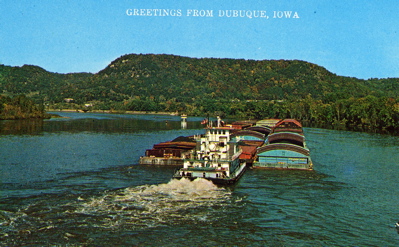Encyclopedia Dubuque
"Encyclopedia Dubuque is the online authority for all things Dubuque, written by the people who know the city best.”
Marshall Cohen—researcher and producer, CNN
Affiliated with the Local History Network of the State Historical Society of Iowa, and the Iowa Museum Association.
BARGE TRAFFIC
BARGE TRAFFIC. Barge traffic has a long history on the MISSISSIPPI RIVER dating back the Northwest Ordinance of 1787 in which Congress guaranteed open barge traffic on the Mississippi. The firm of Archer Daniels Midland (ARM) in 1990 operated a fleet of barges through the American River Transportation Co. (ARTCO) with terminals in Dubuque and McGregor, Iowa and Cassville and Prairie du Chien, Wisconsin. Barges in Dubuque usually carry grain; coal; sand and gravel; fly ash; cement; motor fuels; and salt. A mistaken idea holds that a group of boats tied together is a barge. Each "boat" is actually a barge. "Line boats" push the linked barges up and down the river while "switch boats" break up the tows to deliver barges to terminals for loading and unloading. (1)
Barges are used for bulk items since the cost of hauling goods by barge is very low. In 1990 there were times of the year when Dubuque area farmers could save up to 50% getting their grain to market compared to other means of transportation. In 1989 INTERSTATE POWER COMPANY unloaded 940 barges of coal at its three plants. Wisconsin Power & Light Company burned an estimated 330 barge loads of coal annually. Representatives of both company reported barge traffic being significantly lower than rail transportation saving consumers a great deal of money. (2) In 2015 it was estimated that it would take 58 large semi-tractor trailers or 13 railcars to transport the amount of product carried on a single barge. (3)
A typical barge measures 195 by 35 feet (59.4 m × 10.6 m), and can carry up to 1,500 tons of cargo. Extremely large objects are normally shipped in sections and assembled on site, but shipping an assembled unit reduced costs and avoided reliance on construction labor at the delivery site.
Self-propelled barges may be used when traveling downstream or upstream in placid waters. They are operated as an unpowered barge, with the assistance of a tugboat, when traveling upstream in faster waters.
In 1990 the U. S. Fish and Wildlife Service was negotiating a land swap with ARTCO and NEWT MARINE SERVICE so that the two companies would own barge fleeting sites they have historically used on Pearl Island, south of the JULIEN DUBUQUE BRIDGE and Catfish Island. The sites were appraised at $230,000. The Wildlife service asked the companies to acquire undeveloped industrial-style land of the same value, an estimated 500 acres, to add to the refuge. The fleet sites, appraised for their industrial value, included from between six to ten acres. The Catfish Island fleeting area alone could hold an estimated 100 barges. (3)
Temperatures play an important role in barge traffic. In 2015 above average temperatures in November and December increased the season barges could be used. The time at each lock with some ice could reach from eight to ten hours versus the normal one and one-half to two hours. Eventually ice closed the river to transportation completely. (4) In addition to warm temperatures, barge traffic depended on consistent water levels and avoiding flooding. In 2012 a drought reduced water levels in the Mississippi and Missouri rivers to such an amount that a bipartisan group of senators along both rivers urged President Obama to issue an emergency directive to permit additional water flows from the Missouri River reservoirs. This action, however, was rejected by the Army Corps of Engineers. (5)
Barges carry a variety of products which could pose environmental threats. On June 9, 2008 fifteen fully loaded barges struck the JULIEN DUBUQUE BRIDGE. Fortunately ten of the barges were full of corn, four with soybeans, and one with iron ore. The bridge was closed to traffic until June 10th when Iowa Department of Transportation officials inspected the bridge and found no serious damage to the structure. (6)
Less fortunate was the relationship between barge traffic and the dispersal of ZEBRA MUSSELS. The mussels were first documented in Iowa in 1992 near Burlington. The following year, reports of the mussels came in from the entire length of the Mississippi River bordering Iowa. The mussels by 2011 were found in inland waterways in Wisconsin and the entire length of the Mississippi and the Illinois rivers. (7)
---
Source:
1. Pritchard, Ken, "Barge Traffic a Boon to Tri-State Economy," Telegraph Herald, May 6, 1990, p. 1
2. Ibid., p. 3
3. Montgomery, Jeff, "Barge Traffic Still Humming Along," Telegraph Herald, December 7, 2015, p. 2A
4. Ibid.
5. Schmidt, Eileen Mozinsky, "Traffic Stoppage to Barge In?" Telegraph Herald, December 8, 2012, p. 1
6. Porter, Becka, "Fragile Waters," Telegraph Herald, June 22, 2010, p. 1A
7. Reber, Craig, "Fighting a Foreign Invasion," Telegraph Herald, September 15, 2011, p. 1A


